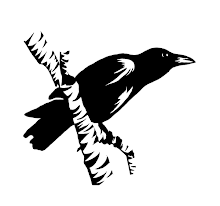Project Two - Butting Seams
The simple nine patch block is an excellent test of your basic accuracy skills...and it's pretty too! Once you master the basic nine patch, you can play with fabric choices to alter the way colour plays out in your quilt. But that's for later. For now, let's go back to refining our accuracy skills.Take those two strip pieces you made in Project One. One set is made of two darks with a light between them, one set is made of two lights with a dark strip between them. Using the most basic strip cutting technique, square up your strips:
and cut the strip sets into 1 1/2" units:
Take two units with the dark strips on the outside, and one unit with the light on the outside. Arrange them thusly on your worktable:
Note that when these strip units are sewn together, two things must happen. First, the stitchlines must match exactly. Second, we have pressed the strips already such that when the strips are laid right sides together for stitching, the seam on one piece is pressed in the opposite direction of the seam on the other piece. This means the folds will abut one another. When they nest together this way, the stitchlines will match exactly:
You are now going to sew the top strip to the middle one, and I baste them together with the basting glue:
To make sure you get the right position, wiggle the seams that butt until you feel them nest and go flat. Hold them up to the light...there should be no lighter strip showing between the darker lines where the pressed seam allowances are. Press lightly to set the glue, but don't shift the alignment of the pieces.Nested properly, the seams should look like this (don't worry if you get a bit of a bulge like I did, just put that side down and the feed dogs will ease the bulk in):
Examine the intersections of the squares of colour. They should come together in a perfect + with no overlapping of edges:
If your edges do not meet perfectly, that means either your strips were not the right size, or your 1/4" seam was not the right width, or you just didn't get your pieces and seams butted up carefully.
Go back and check what went wrong, and make these over until you get it right.
Now glue baste the lower piece in place, and sew it on, pressing the finished stitch line, then pressing the seam allowance toward the strip with the two darker squares. You should now have a perfect little nine patch:
A further test of your accuracy skills is to make 9 of these little nine patches, and then sew them together into a grid. Boy howdy, will that give you practice in getting nice little perfect blocks whose seams nest perfectly and where all the colours meet in crisp fashion!
You can also add in another fabric, and/or fiddle with the fabric placements to achieve a design that pleases you. It is extremely helpful to use quilting software to preview design choices. Using three fabrics, you could potentially make all of the blocks below:
Note that by alternating the nine patches with plain squares cut to the same size as the nine patch blocks, in this case 3 1/2" x 3 1/2", you can create a lovely little quilt pattern:
Those plain squares are fabulous for showcasing quilting stitches, or a little hand embroidery or embellishment. The possibilities are endless, and making up some baby or lap quilts based on this simple design allows you to experiment with fabric choices, colour patterns and the effects of different embellishments.











